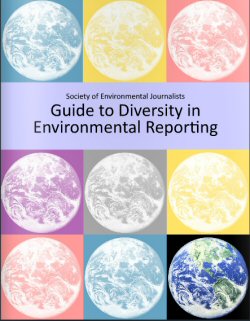Find fellowships, conferences, grants and awards deadlines, workshops and networking opportunities, crowd-sourced leads to job banks, reporting toolkits, hundreds of MOOCs and more. GO >>
 The Society of Environmental Journalists published this excellent resource for journalists who want to address diversity concerns and practice more inclusive journalism:
The Society of Environmental Journalists published this excellent resource for journalists who want to address diversity concerns and practice more inclusive journalism:
SEJ’s "Guide to Diversity in Environmental Reporting" by Jennifer Oladipo, editor (left), and Talli Nauman, associate editor (right).
 |
 |
- Download the PDF (3.69 MB) or view, share and download here.
- “Print on demand” is available at cost from MagCloud.
Authors Oladipo and Nauman were inspired to create the guide by discussions by members of SEJ’s Diversity Task Force (now the Diversity, Equity and Inclusion Committee). Their focus is mainly journalistic practice in North America. Journalists who have not consciously addressed diversity in their work should find multiple entry points here.
Grant funds for researching, writing and producing SEJ’s "Guide to Diversity in Environmental Reporting" were provided by the Gannett Foundation. The Guide was published in 2013.
From the introduction:
“The climate for environmental journalism is changing in more ways than one. Even as we work to tell the story of a natural and technological world in constant flux, we must also respond to a society that is seeing demographic shifts whose impacts we can never fully anticipate.
Already by 2011, so-called minorities constituted the majority in 22 of the 100 largest U.S. metropolitan areas. By 2012, the group classified as “white” by the U.S. Census Bureau accounted for fewer than half of newborns in the United States. Issues related to gender and sexuality are pervasive in entertainment media and openly examined in the courts of law. An aging population is triggering responses in various sectors preparing for an era where the needs of older and disabled persons must become priority. At the same time, income inequality is becoming more acute, urbanization more rapid, and the journalism business more uncertain.
Yet since long before this period of demographic churning began to signal change, the demand for addressing diversity and practicing more inclusive journalism has been glaring, to those who have investigated the issue. Environmental journalism has been no different.
The need is longstanding for greater participation by and coverage of the perspectives of women, racial and ethnic groups, age groups, and people of various orientations, abilities and geographics.
Representation means perspectives, stories, sources, journalists, editors, publishers.
There is a lot of work to do, and this guide aims to be a resource for environmental journalists who want to better understand the landscape in which we report, and how to actively participate in making sure journalism measures up. To that end, we have drawn upon numerous sources that together will hopefully help any journalist to move in that direction. The focus is mainly journalistic practice in the United States and North America. Those who seek to address diversity in their work will find multiple entry points here. Others who already make it a part of their philosophy should find ways to deepen their engagement and expand their reporting."












 Advertisement
Advertisement 



